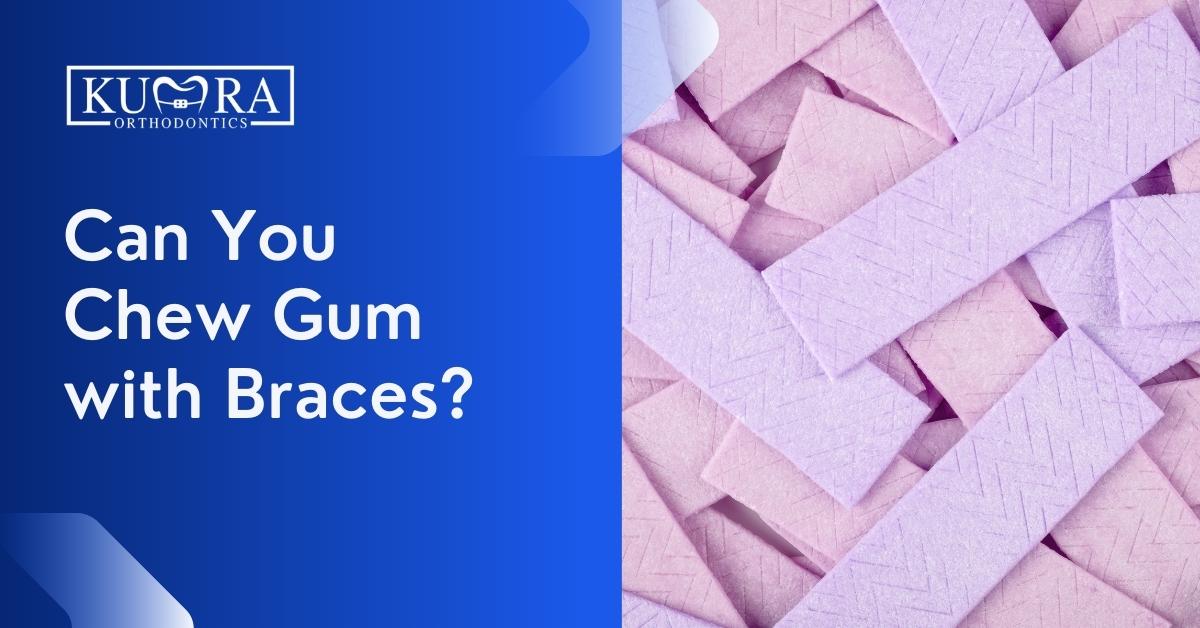For many people, orthodontic treatment is a reasonable option for improving their oral health. The function of chewing and biting down is enhanced, and a patient’s smile appears. Despite its promise of a straighter smile, orthodontic treatment is not without some of its drawbacks.
You have nothing to be afraid of because getting braces on your teeth doesn’t hurt at all. After the orthodontic wire is inserted into the brackets, slight soreness or discomfort may remain for a few days.
In this article, we’ll answer the question, “can you eat gum with braces”.
Gum and Braces
Brackets are placed on each of the teeth, and a strong wire is used to join them all together. At each dental appointment, those brackets will be changed (or rotated) slightly so that individual teeth can slowly but steadily migrate into the correct position. The foundation of excellent and effective dental braces is a strong wire that holds teeth in the correct place.
Teeth can move out of place if the main brace wire is bent due to chewing gum or other things that put extra force on it. In the worst-case situation, the user’s teeth may begin to shift out of place, resulting in additional dental issues. Braces can create discomfort or dental health difficulties if chewing gums become stuck to the metal framework.
Related: How Long Can You Go With a Loose Bracket?
Alternatives to Chewing Gum
You may have observed that when your dentist places braces on your teeth, they will go on and on about how sugary foods are horrible for your teeth and should be avoided at all costs. This is primarily due to the sticky nature of sugar.
Tooth decay becomes more likely as the sugary film that coats teeth for an extended time grows more persistent. Abrasions can make it challenging to remove hard-to-reach sweet items (such as chewing gum), allowing them to remain on teeth for a time that is impossible to estimate.
Sugarless Gum
More durable brackets and wires in today’s braces greatly reduce the danger of gum damage. Our ability to accommodate chewing gum while wearing braces has improved as a result. If you’re wearing braces, you’ll want to stick to sugar-free gum. When you’re unable to clean your teeth after a meal, an American Dental Association report suggests that chewing sugarless gum for 20 minutes can help avoid tooth decay. Gum chewing results in an increase in salivation. Only sugarless gums have the ADA Seal to date. They’re sweetened with sugar substitutes like aspartame, sorbitol, xylitol, or mannitol, none of which cause cavities in the mouth. Researchers have discovered that chewing sugarless gum helps stimulate saliva production, reduce plaque acid levels, strengthen teeth, and reduce decay.
While wearing braces, chewing gum might help strengthen the teeth’s roots, which are put under stress. Dentists advise patients to chew a little piece of gum only while experiencing tooth discomfort and spit it out as soon as the pain subsides. They are then instructed to brush their teeth and braces and continue their oral hygiene regimen until their next meal.
Needing an orthodontic appointment?
Visit Kumra Orthodontics Washington DC or Kumra Orthodontics Stafford, VA, and request an appointment with us!
Brushing and Flossing
If you’re using gum as a cavity-preventative measure, try doubling down on your brushing and flossing habits. Brushing and flossing twice a day, cleaning your teeth after meals, and drinking plain water can all help you attain the same results.
Read More: The Proper Way to Floss with Braces
Mints
Sugar-free breath mints or mouthwash can be used instead of chewing gum to refresh one’s breath. Keep in mind that hard mints could break a bracket if you’re not careful.
Other Considerations
In the worst case scenario, it could get caught in your braces. If it occurs, you’ll need to go to work cleaning it right away. You can remove as much of the gum as you can by brushing it away with your teeth. Scrubbing too vigorously could damage your brackets and wiring, so be careful.
Your brackets or teeth may be covered in gum. Use normal dental floss to get it out of the crevices and cracks. Brush your teeth lightly one more time if there is any remaining gum. It should have loosened up after you flossed it.
What if you can’t seem to get rid of all the gum stuck in your braces? If you haven’t seen your orthodontist in a while, make an appointment right soon. They can provide you with a thorough cleaning without putting your wires at risk. At your next dental checkup, even if you don’t require orthodontic treatment now, tell your dentist about the incident so they can check for any possible movement.
Contact Kumra Orthodontics to learn more about gum and braces
You may contact our office at Kumra Orthodontics if you have any questions or concerns about orthodontic treatment.


